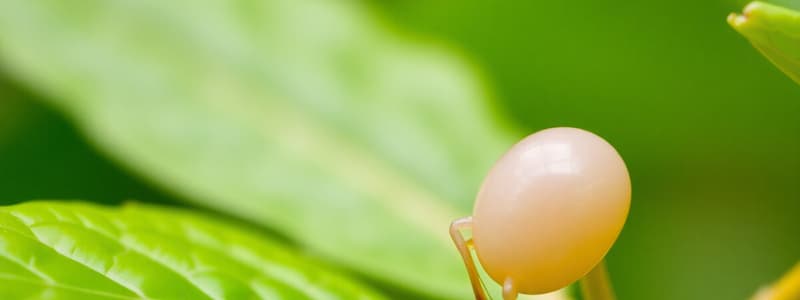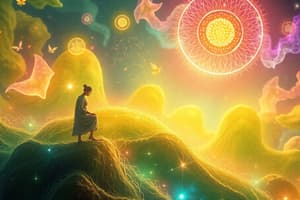Podcast
Questions and Answers
A scientist discovers a new object. Which of the following must be true for the scientist to classify the object as living?
A scientist discovers a new object. Which of the following must be true for the scientist to classify the object as living?
- The object demonstrates all eight characteristics of life recognized by biologists, though they may be expressed differently. (correct)
- The object consumes other biotic material to sustain itself.
- The object visibly moves and responds to external stimuli.
- The object possesses at least six of the eight characteristics universally recognized by biologists.
Why might it be difficult to determine if something is living or non-living?
Why might it be difficult to determine if something is living or non-living?
- Living things might display the characteristics of life differently, which can make them harder to spot. (correct)
- Non-living things also reproduce and create offspring, which can be confusing.
- Living things have the same characteristics as non-living things.
- Living things are only determined by consumption of biotic material.
Consider a rock covered in lichen. Which is biotic and which is abiotic?
Consider a rock covered in lichen. Which is biotic and which is abiotic?
- The rock is biotic, and the lichen is abiotic.
- The rock is abiotic, and the lichen cannot be determined.
- The rock is biotic, and the lichen cannot be determined.
- The rock is abiotic, and the lichen is biotic. (correct)
A tree doesn't move when you touch it. How can it still be considered living if responding to stimuli is a characteristic of life?
A tree doesn't move when you touch it. How can it still be considered living if responding to stimuli is a characteristic of life?
How do these eight characteristics of life help biologists?
How do these eight characteristics of life help biologists?
Which of the following is the MOST accurate distinction between biotic and abiotic factors?
Which of the following is the MOST accurate distinction between biotic and abiotic factors?
A scientist discovers a new organism. Which characteristic MUST be present for the scientist to classify the organism as living?
A scientist discovers a new organism. Which characteristic MUST be present for the scientist to classify the organism as living?
A plant bends towards a window. Which characteristic of life does this BEST exemplify?
A plant bends towards a window. Which characteristic of life does this BEST exemplify?
Which of the following examples BEST illustrates heredity?
Which of the following examples BEST illustrates heredity?
Which of the following accurately describes the difference between sexual and asexual reproduction?
Which of the following accurately describes the difference between sexual and asexual reproduction?
A population of insects gradually becomes resistant to a specific pesticide over several generations. What characteristic of life does this BEST represent?
A population of insects gradually becomes resistant to a specific pesticide over several generations. What characteristic of life does this BEST represent?
Which of the following is an example of maintaining homeostasis in animals?
Which of the following is an example of maintaining homeostasis in animals?
Why is a virus NOT considered a living organism, despite possessing genetic material and the ability to reproduce?
Why is a virus NOT considered a living organism, despite possessing genetic material and the ability to reproduce?
Which of the following observations would BEST support the conclusion that a newly discovered organism undergoes metabolism?
Which of the following observations would BEST support the conclusion that a newly discovered organism undergoes metabolism?
A group of cells works together to perform a specific function. This is an example of what characteristic of life?
A group of cells works together to perform a specific function. This is an example of what characteristic of life?
Flashcards
Biology
Biology
The scientific study of life.
Characteristics of Life
Characteristics of Life
To be considered alive, an object must exhibit all eight properties.
Response to Stimuli
Response to Stimuli
The ability to react to changes in the environment.
Biotic
Biotic
Signup and view all the flashcards
Abiotic
Abiotic
Signup and view all the flashcards
Reproduction
Reproduction
Signup and view all the flashcards
Heredity
Heredity
Signup and view all the flashcards
Cellular Organization
Cellular Organization
Signup and view all the flashcards
Growth and Development
Growth and Development
Signup and view all the flashcards
Adaptation Through Evolution
Adaptation Through Evolution
Signup and view all the flashcards
Homeostasis
Homeostasis
Signup and view all the flashcards
Metabolism
Metabolism
Signup and view all the flashcards
Study Notes
- Biology is the study of life.
Characteristics of Life
- To be considered alive, an object must possess all eight characteristics of life.
- Organisms can display these characteristics differently, which can be hard to spot.
- Biotic things are living and have all 8 characteristics of life.
- Abiotic things are nonliving and are missing one or more of the characteristics.
Reproduction
- Living things must be able to reproduce and create offspring.
- Can be sexual (genetic material from multiple parents) or asexual (genetic material from one parent).
- Meiosis and mitosis are forms of asexual reproduction.
Heredity
- The ability to pass on genetic material (DNA) from parent to offspring, including phenotypic and genotypic traits.
- Offspring inherit traits such as fur length and color.
Cellular Organization
- All living things are composed of one or more cells.
- The number and structure of cells can vary among organisms.
- Humans have 37.2 trillion cells of 200 different types.
- Single-celled organisms only contain one.
Growth and Development
- All organisms develop over time to become more physically and mentally mature.
- The life cycle of a frog is a good example of how organisms grow and develop
Adaptation Through Evolution
- Every living thing has evolved and continues to adapt to its environment.
- Fossils show evolution over time; the oldest are 3.5 billion-year-old cyanobacteria.
- Organisms with traits that increase their survival rate are more likely to reproduce.
- The evolution of adaptations that increase survival rate are the primary idea behind Darwin's famous "survival of the fittest."
- Peacock butterflies have evolved eyespots to scare away predators, increasing survival.
Response to Stimuli
- Living things respond to stimuli in their environment.
- A morning dove seeking shade due to heat is an example, with the external temp being stimulus.
- Flowering plants turning to face sunlight is a response to stimuli.
- Abiotic rocks do not respond to stimuli.
Homeostasis
- A living thing's ability to maintain stable internal factors.
- Examples: Blood pressure, thermoregulation, and water balance within cells.
- Endotherms (warm-blooded organisms) regulate internal temperature.
- Essential for good health
Metabolism
- An organism must use chemical reactions to process resources from the environment.
- Involves bodily functions that must be maintained to avoid illness.
- Most metabolic processes convert food into energy.
- Photosynthesis is a major metabolic pathway in plants
- Energy from the sun converted into usable energy for the plant to grow and function.
- Converted through reactions to become glucose, a sugar compound used by organisms for energy.
Studying That Suits You
Use AI to generate personalized quizzes and flashcards to suit your learning preferences.




